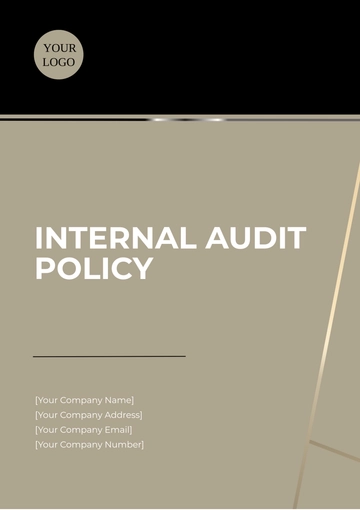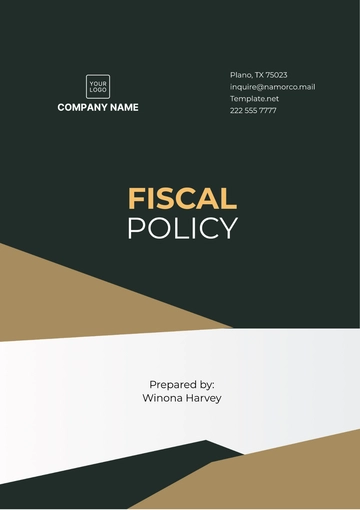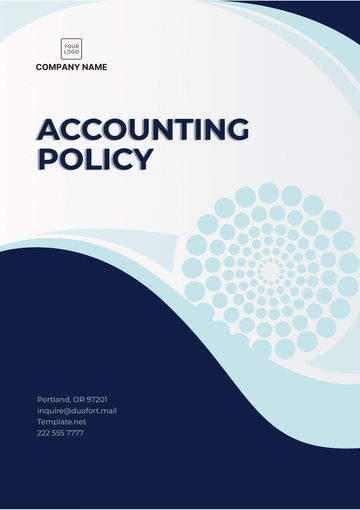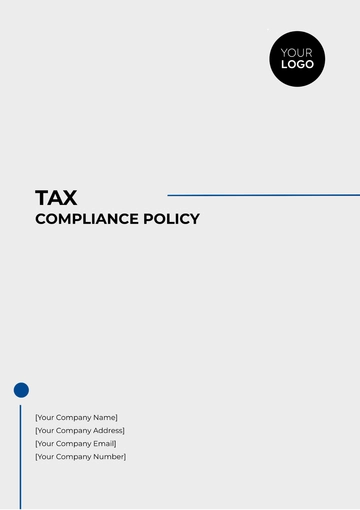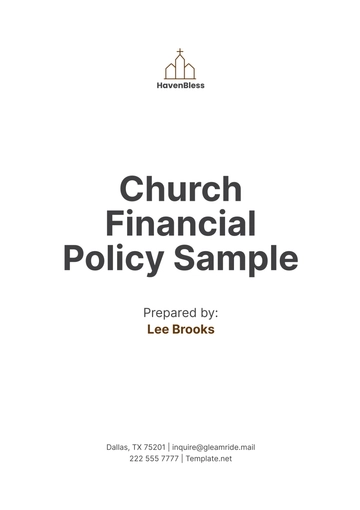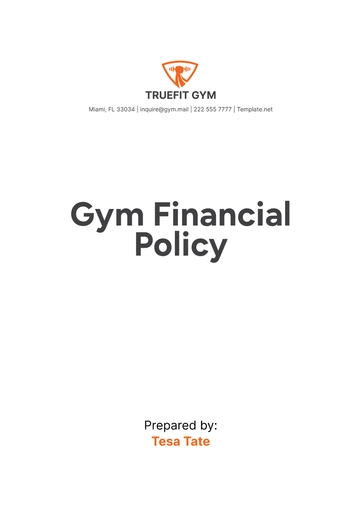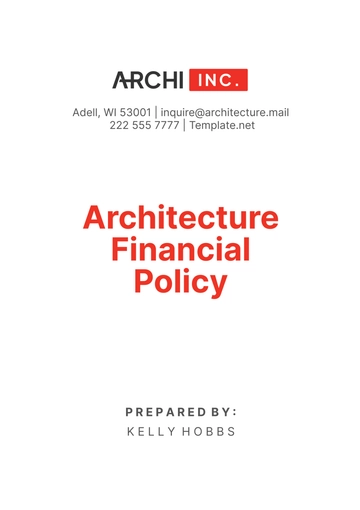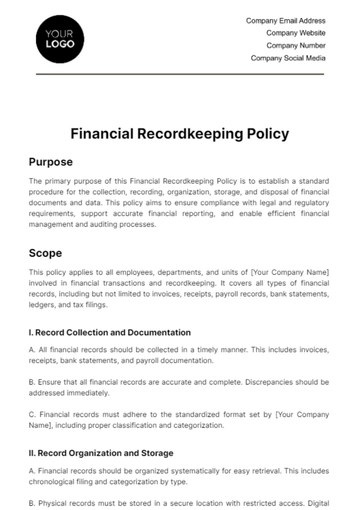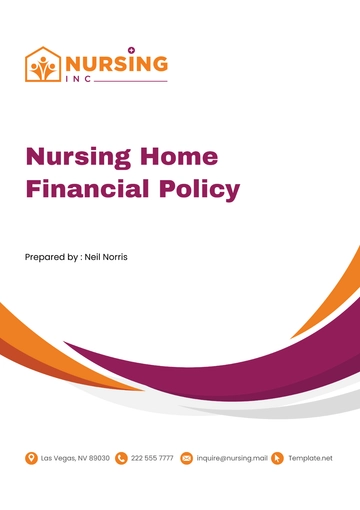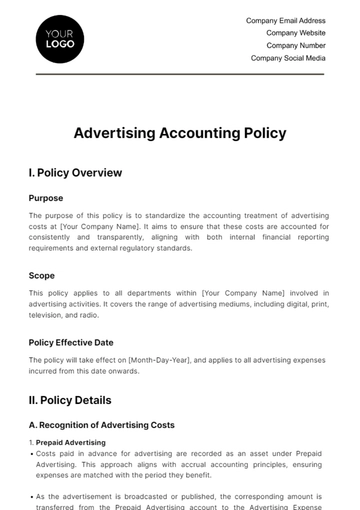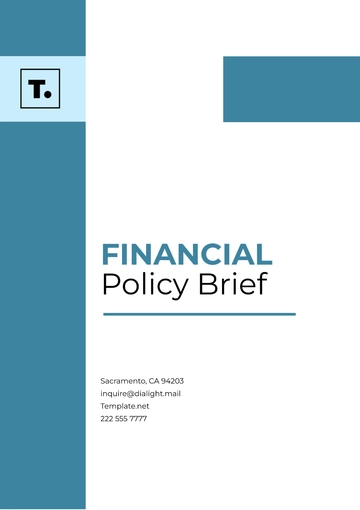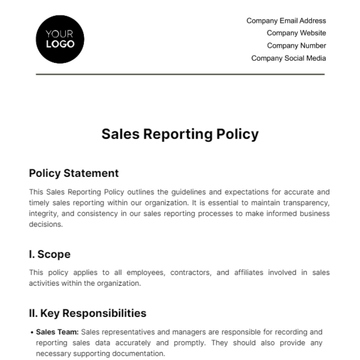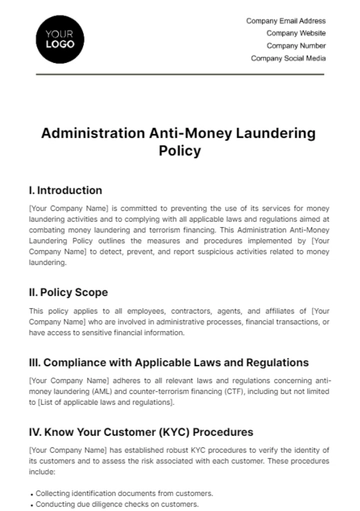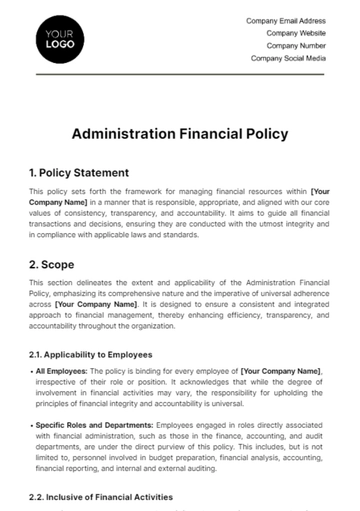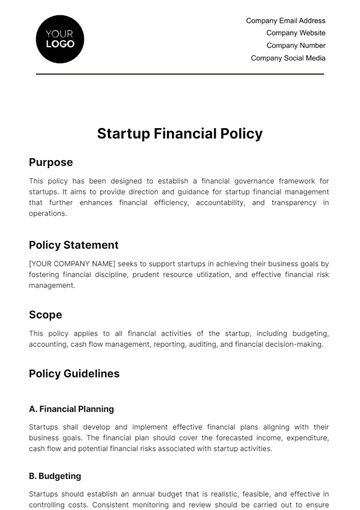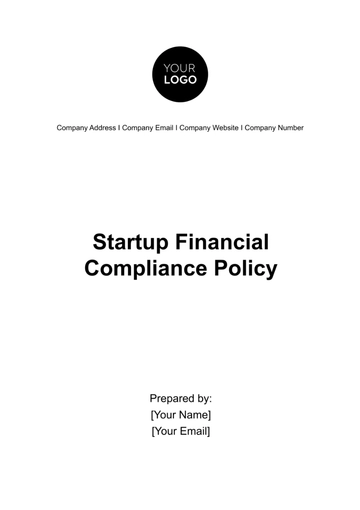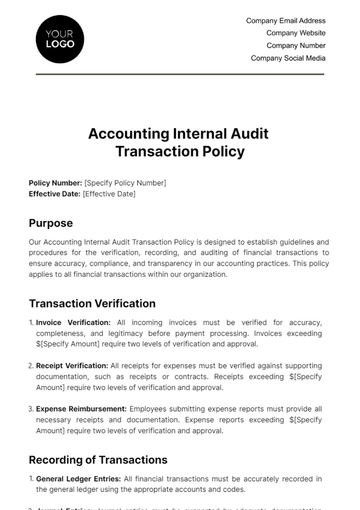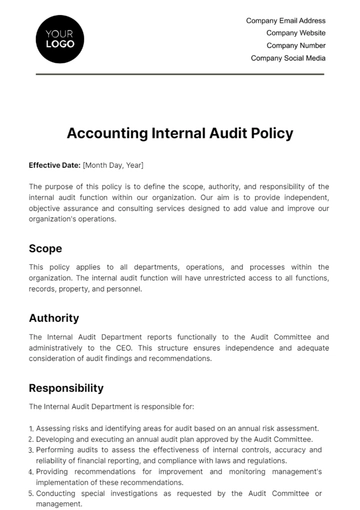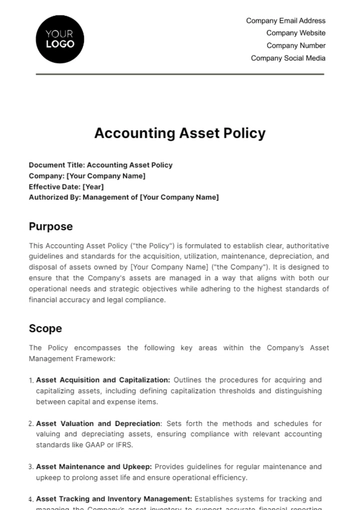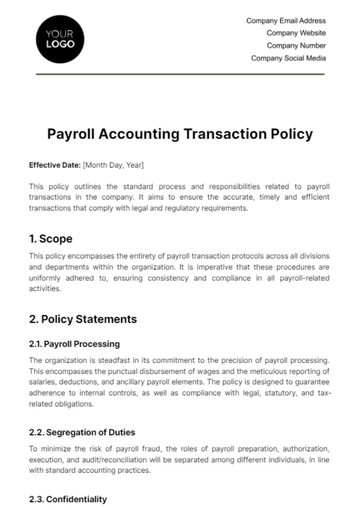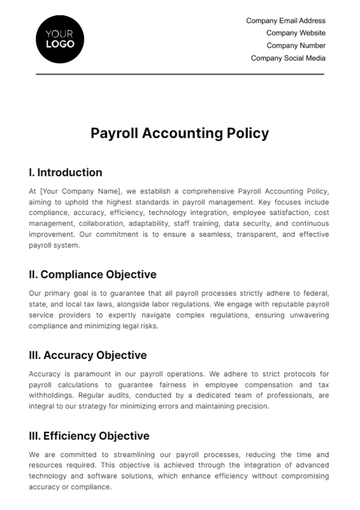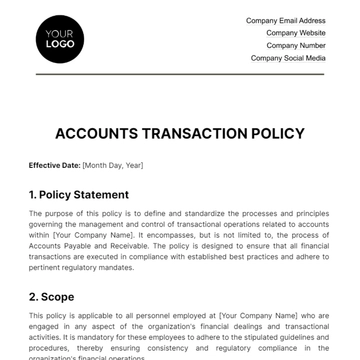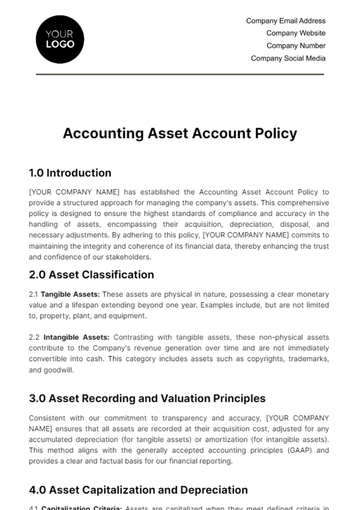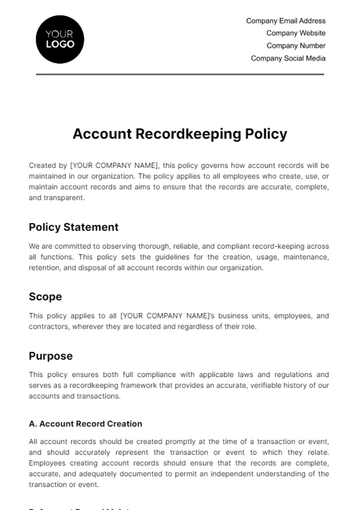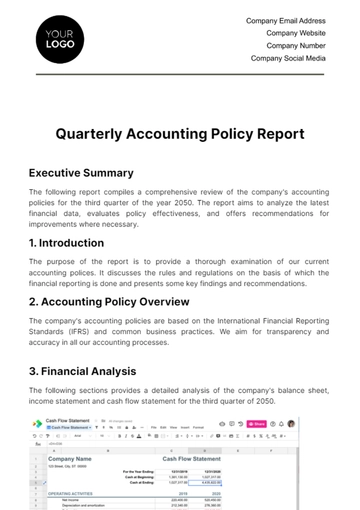Free Church Financial Policy Sample
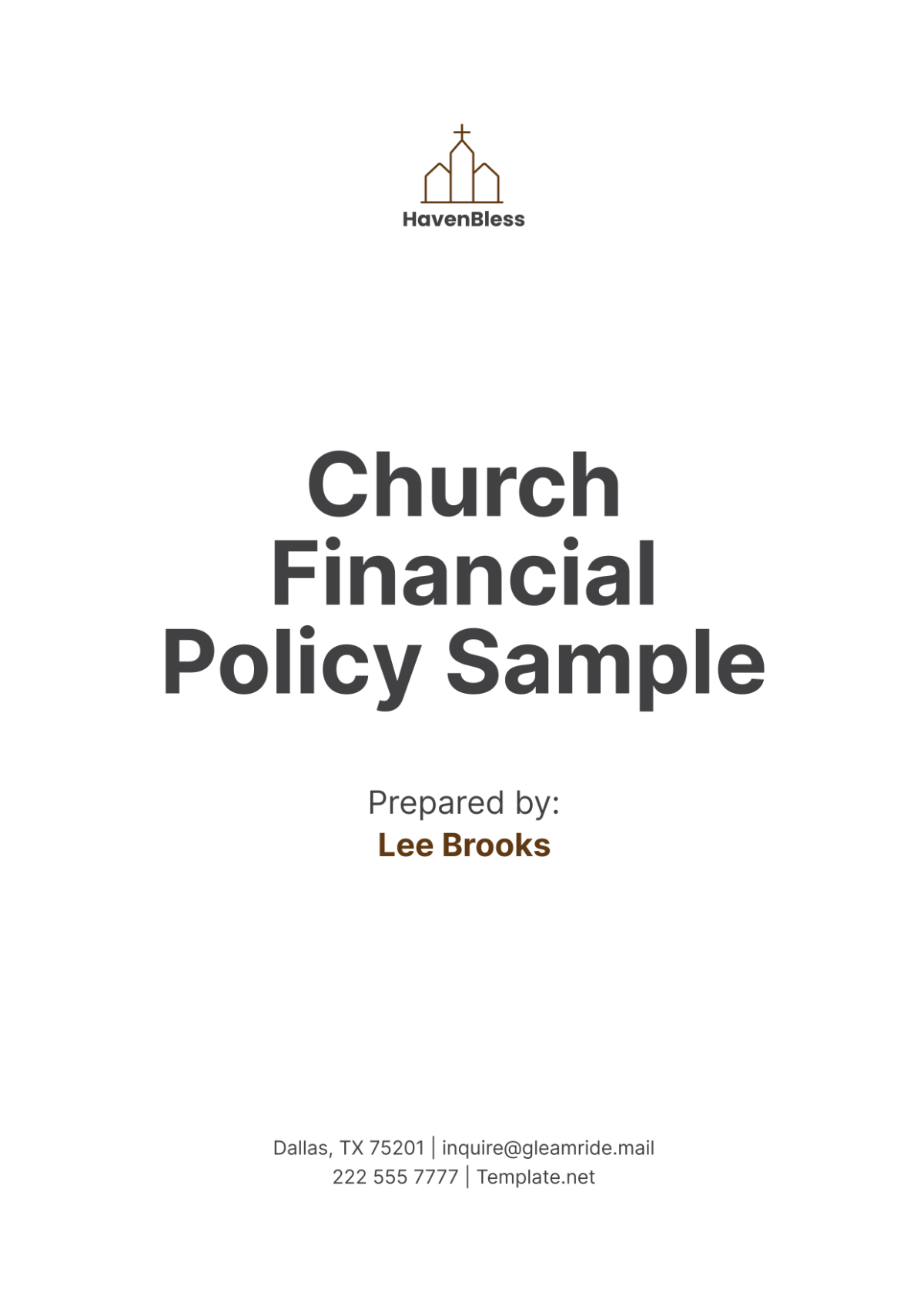
I. Introduction
A. Purpose of the Policy
The purpose of this Church Financial Policy is to establish a structured and transparent approach to managing the financial resources of [Your Company Name] (hereinafter referred to as "the Church"). By setting clear guidelines and procedures, this policy aims to promote accountability and integrity in financial matters. It serves as a roadmap for financial management, ensuring that all financial transactions and activities are conducted with transparency and are in alignment with the Church’s mission and ethical standards. This policy is designed to safeguard the Church’s assets, ensure compliance with legal and regulatory requirements, and support effective stewardship of resources.
B. Scope
This policy applies to all financial activities within the Church, covering aspects such as budgeting, expenditures, donations, and financial reporting. It encompasses all individuals involved in financial operations, including staff, volunteers, and members of the Church. The policy also extends to any affiliated entities or ministries operating under the Church’s supervision. It is essential that all personnel involved in financial matters adhere to the guidelines set forth in this policy to maintain consistency and integrity in financial operations.
C. Objectives
Transparency: To maintain openness in all financial transactions and reporting, ensuring that all stakeholders have access to accurate and timely information regarding the Church’s financial status. This includes providing detailed financial reports and disclosures to both internal and external stakeholders.
Accountability: To ensure that all financial activities are conducted with the highest level of responsibility and ethical standards. This involves clear documentation, approval processes, and regular audits to monitor financial performance and address any discrepancies.
Compliance: To adhere to all applicable legal and regulatory requirements governing financial management. This includes compliance with tax laws, reporting requirements, and any other regulations that impact the Church’s financial operations.
Sustainability: To manage financial resources effectively to support the Church’s mission and long-term goals. This involves strategic planning, prudent investment, and responsible budgeting to ensure the Church’s financial stability and growth.
II. Financial Management
A. Budgeting
1. Annual Budget Preparation
The annual budget is a critical financial plan that outlines the Church’s expected revenues and expenditures for the upcoming fiscal year. It is developed by the Finance Committee and requires approval from the Board of Elders before it can be implemented.
1.1 Budget Components
Revenue Projections: This section includes anticipated income from various sources such as tithes, offerings, grants, and fundraising activities. Historical data, current economic conditions, and projected changes in membership or giving patterns are considered to create accurate revenue forecasts.
Expense Estimates: This section covers all expected costs associated with Church operations, including salaries, utilities, maintenance, program expenses, and other operational costs. It ensures that all necessary expenditures are accounted for and that there are sufficient funds allocated for each area.
Capital Expenditures: This includes planned investments in property, equipment, and other significant assets. Capital expenditures are evaluated based on their potential impact on the Church’s mission and long-term sustainability.
1.2 Budget Approval Process
The Finance Committee drafts the initial budget using input from various departments and ministries. This draft is reviewed and revised as necessary before being presented to the Board of Elders. The Board of Elders examines the budget in detail, makes any final adjustments, and provides formal approval. The approved budget is then implemented at the start of the fiscal year.
2. Budget Monitoring and Adjustments
2.1 Monitoring
Monthly financial reports are generated to track actual performance against the budgeted figures. These reports include detailed income statements, balance sheets, and cash flow statements. The Finance Committee reviews these reports to monitor financial performance and ensure that expenditures are within budgeted limits.
2.2 Adjustments
In the event of significant variances between budgeted and actual figures, the Finance Committee investigates the reasons for discrepancies. Based on their findings, they recommend adjustments to the budget or financial strategies. Major adjustments, particularly those involving substantial changes to planned expenditures, require approval from the Board of Elders.
B. Financial Reporting
1. Monthly Reports
Monthly financial reports provide a comprehensive view of the Church’s financial status and performance. These reports are essential for ongoing financial management and decision-making.
Income Statement: This report shows the Church’s revenues, expenses, and net income for the month. It provides insights into financial performance and highlights any significant changes in income or expenditure patterns.
Balance Sheet: This document lists the Church’s assets, liabilities, and equity. It offers a snapshot of the Church’s financial position and helps assess liquidity, solvency, and overall financial health.
Cash Flow Statement: This statement highlights cash inflows and outflows, providing an overview of the Church’s cash position. It helps in understanding cash management and identifying potential liquidity issues.
1.1 Distribution
Monthly reports are distributed to the Board of Elders, Finance Committee members, and other key stakeholders. Summarized versions of the reports may also be shared with the congregation to keep them informed about the Church’s financial health.
2. Annual Financial Statements
Annual financial statements are comprehensive documents that provide an overview of the Church’s financial activities over the entire fiscal year. These statements are crucial for transparency and accountability.
2.1 Components
Audited Financial Statements: These statements are prepared by an independent auditor to ensure accuracy and compliance with accounting standards. They include detailed financial information and are accompanied by the auditor’s opinion on the Church’s financial statements.
Annual Report: This report summarizes the Church’s financial performance, achievements, and challenges over the year. It includes key financial highlights, strategic goals, and an overview of major projects or initiatives.
2.2 Publication
Annual financial statements are published on the Church’s website and made available to congregation members upon request. A summary of the annual report is presented during the annual general meeting, providing an opportunity for members to ask questions and receive updates on the Church’s financial status.
III. Financial Procedures
A. Cash Handling
1. Cash Receipts
1.1 Collection
All cash and checks received are collected by designated ushers or staff members during services or events. These funds are then deposited into the Church’s bank accounts within 48 hours to minimize the risk of theft or loss. Proper procedures are followed to ensure that all cash handling is secure and accountable.
1.2 Recording
Each deposit is recorded in a cash receipt log, which includes details such as the date, amount, and source of funds. The log is maintained accurately and reconciled with bank statements monthly. This process helps in tracking all cash transactions and ensuring that deposits match recorded amounts.
2. Cash Disbursements
2.1 Authorization
All cash disbursements must be authorized by a designated signatory who is responsible for approving expenditures. Payments are made through checks or electronic transfers, and all disbursements must be accompanied by appropriate documentation, such as invoices or receipts. The authorization process helps prevent unauthorized or fraudulent payments.
2.2 Documentation
Supporting documents, including invoices, receipts, and purchase orders, must accompany all disbursement requests. Documentation is reviewed for accuracy and completeness before processing payments. This ensures that all disbursements are legitimate and properly accounted for.
B. Expense Reimbursements
1. Reimbursement Requests
1.1 Submission
Staff and volunteers seeking reimbursement for out-of-pocket expenses must submit a reimbursement request form. This form should be accompanied by original receipts and submitted within 30 days of incurring the expense. Timely submission of reimbursement requests helps in maintaining accurate financial records and ensures that reimbursements are processed efficiently.
1.2 Approval
Reimbursement requests are reviewed and approved by the Finance Committee or a designated approver. The review process includes verifying the validity of the expenses and ensuring that they comply with Church policies. Approved requests are processed within 14 days, and reimbursement payments are made promptly.
2. Travel Expenses
2.1 Policy
Travel expenses incurred by staff or volunteers must be pre-approved by the Finance Committee. Reimbursable travel expenses include transportation, lodging, and meals, subject to predefined limits set by the Church. The travel policy outlines allowable expenses and helps control costs associated with travel.
2.2 Documentation
Travel expense reports must include receipts and a detailed travel itinerary. Mileage reimbursement is calculated based on the current IRS mileage rate. Proper documentation is essential for verifying travel expenses and ensuring compliance with reimbursement policies.
IV. Financial Controls
A. Internal Controls
1. Segregation of Duties
Key financial responsibilities are divided among different individuals to reduce the risk of errors, fraud, or mismanagement. This segregation ensures that no single individual has control over all aspects of financial transactions.
1.1 Responsibilities
Receipts Handling: Collected by one individual and deposited by another to ensure checks and balances in the handling of cash.
Disbursements: Authorized by one person and processed by another to prevent unauthorized payments and maintain oversight.
Record-Keeping: Managed separately from cash handling and authorization to ensure accurate and independent financial records.
2. Reconciliation
2.1 Bank Reconciliation
Monthly bank reconciliations are performed to ensure that the Church’s financial records match bank statements. Any discrepancies between the Church’s records and the bank statement are investigated and resolved promptly. Regular reconciliations help maintain accurate financial records and detect potential issues early.
2.2 Audit Trail
A clear audit trail is maintained for all financial transactions, including transaction logs, approval records, and supporting documentation. This audit trail provides transparency and accountability, making it easier to trace and verify financial activities.
B. Fraud Prevention
1. Fraud Policies
1.1 Zero Tolerance
The Church has a zero-tolerance policy for fraud and financial misconduct. All instances of suspected fraud must be reported immediately to the Finance Committee or designated fraud prevention officer. The Church takes allegations of fraud seriously and investigates all reported incidents thoroughly.
1.2 Investigation
The Finance Committee or an appointed auditor conducts investigations into reported fraud or financial irregularities. The investigation process includes gathering evidence, interviewing witnesses, and reviewing financial records. Based on the findings, corrective actions are taken to address the issue and prevent future occurrences.
2. Training
2.1 Staff Training
All staff and volunteers involved in financial activities receive regular training on fraud prevention, ethical conduct, and compliance with financial policies. Training sessions are designed to raise awareness about potential fraud risks and ensure that individuals understand their responsibilities in preventing financial misconduct.
2.2 Policy Review
The Church’s financial policies are reviewed annually to ensure they remain effective in preventing fraud and addressing emerging risks. Policy reviews involve evaluating current procedures, incorporating feedback, and making necessary updates to enhance fraud prevention measures.
V. Fundraising and Donations
A. Donation Management
1. Types of Donations
1.1 Tithes and Offerings
Regular contributions from congregation members, classified as tithes and offerings, are a primary source of income for the Church. These funds are used to support general operations, ministries, and outreach programs. The Church encourages consistent giving and provides various methods for making contributions, including online giving and direct bank transfers.
1.2 Special Contributions
Special contributions include one-time gifts, memorials, and designated donations for specific projects or needs. These contributions may be solicited through special campaigns or events and are often used to fund specific initiatives or cover unexpected expenses.
2. Acknowledgment and Receipts
2.1 Acknowledgment
All donations are acknowledged with a thank-you letter or receipt, expressing gratitude for the donor’s support. The acknowledgment includes details of the donation and its impact on the Church’s mission. Annual summaries of donations are provided to donors for tax purposes and to recognize their generosity.
2.2 Receipts
Receipts are issued for all donations over $250, as required by tax laws. Receipts include the donor’s name, donation amount, and date. This documentation is essential for donors’ tax reporting and for maintaining accurate records of contributions.
B. Fundraising Events
1. Event Planning
1.1 Approval
All fundraising events must be approved by the Finance Committee and the Board of Elders. The event planning process includes defining objectives, establishing budgets, and setting fundraising targets. Approval ensures that events align with the Church’s mission and financial goals.
1.2 Execution
Event coordinators are responsible for organizing and executing fundraising events according to approved plans. This includes managing logistics, coordinating volunteers, and promoting the event. Post-event financial reports are prepared to evaluate the success of the event and ensure proper accounting of funds raised.
2. Reporting
2.1 Financial Reporting
A detailed financial report is prepared for each fundraising event, including a breakdown of income and expenses. The report is reviewed by the Finance Committee and shared with event participants to provide transparency and accountability.
2.2 Evaluation
The effectiveness of fundraising events is evaluated based on financial outcomes, participant feedback, and overall success in achieving fundraising goals. Lessons learned from each event are used to improve future fundraising efforts and enhance the Church’s ability to engage with the community.
VI. Investment and Asset Management
A. Investment Policy
1. Investment Goals
1.1 Objective
The Church’s investment policy aims to preserve capital, generate income, and support the Church’s mission. Investments are managed to balance risk and return, with a focus on maintaining financial stability and achieving long-term growth. The investment strategy is designed to align with the Church’s values and financial goals.
1.2 Types of Investments
Allowed investments include bonds, mutual funds, and other low-risk securities. High-risk investments, such as speculative stocks or ventures, are avoided to protect the Church’s financial assets. The investment portfolio is reviewed regularly to ensure it remains aligned with the Church’s objectives and risk tolerance.
2. Investment Oversight
2.1 Investment Committee
An Investment Committee oversees the Church’s investment portfolio, including selecting investment managers, reviewing performance, and making recommendations for adjustments. The committee meets quarterly to assess investment performance and adjust strategies as needed.
2.2 Reporting
Quarterly investment reports are provided to the Finance Committee and Board of Elders. These reports include summaries of investment performance, market conditions, and any changes to the portfolio. The reports facilitate informed decision-making and ensure that investment activities are aligned with the Church’s goals.
B. Asset Management
1. Property Management
1.1 Maintenance
All Church properties are maintained in good condition through regular inspections and maintenance activities. Maintenance requests are processed promptly to address any issues and ensure that properties are safe and functional. Preventive maintenance is conducted to minimize the risk of major repairs and extend the life of Church assets.
1.2 Leasing
Leasing agreements for Church properties are managed by the Finance Committee, which reviews lease terms, negotiates agreements, and ensures compliance with Church policies. All leases are evaluated for their financial impact and alignment with the Church’s mission.
2. Equipment Management
2.1 Acquisition
New equipment purchases must be approved by the Finance Committee, which assesses the need for the equipment, evaluates costs, and ensures that purchases align with the Church’s budget and strategic goals. Equipment acquisitions are made based on careful consideration of functionality and cost-effectiveness.
2.2 Inventory
An inventory of all Church equipment is maintained and updated regularly. Equipment is tracked to ensure that it is accounted for and properly utilized. Periodic audits are conducted to verify the accuracy of inventory records and prevent loss or misuse.
VII. Compliance and Legal Matters
A. Legal Compliance
1. Regulatory Requirements
1.1 Tax Compliance
The Church complies with all federal, state, and local tax regulations, including maintaining tax-exempt status and filing required tax returns. Compliance ensures that the Church operates within legal frameworks and avoids potential legal issues.
1.2 Reporting
Regular financial reports and disclosures are submitted to regulatory agencies as required. This includes annual tax filings, financial statements, and other documentation necessary for maintaining compliance with legal and regulatory requirements.
2. Legal Counsel
2.1 Engagement
The Church engages legal counsel to provide advice on financial and legal matters. Legal counsel is consulted for issues related to compliance, contracts, and other legal matters that impact the Church’s operations.
2.2 Documentation
All legal documents, including contracts, agreements, and legal opinions, are carefully reviewed and maintained. Documentation is stored securely and is accessible for reference and review as needed.
VIII. Policy Review and Updates
A. Review Process
1. Annual Review
The Church Financial Policy is reviewed annually to ensure that it remains relevant and effective. The review process involves evaluating current practices, identifying areas for improvement, and incorporating changes based on feedback and regulatory updates.
1.1 Feedback
Feedback from staff, volunteers, and stakeholders is collected to identify potential issues and areas for improvement. This feedback is used to refine policies and procedures and enhance overall financial management.
1.2 Updates
Necessary updates to the policy are made based on the review process. Updated policies are communicated to all relevant parties, and training is provided to ensure that everyone is aware of and adheres to the revised guidelines.
B. Communication
1. Dissemination
Revised policies and updates are disseminated to all staff, volunteers, and stakeholders. This includes providing copies of the updated policy, holding informational meetings, and ensuring that everyone is informed about changes and new procedures.
1.1 Training
Training sessions are conducted to familiarize staff and volunteers with updated policies and procedures. This ensures that everyone understands their responsibilities and the implications of any changes to the policy.
2. Acknowledgment
All individuals involved in financial activities are required to acknowledge receipt and understanding of the updated policy. Acknowledgments are documented and maintained as part of the Church’s records.
IX. Conclusion
The Church Financial Policy is a vital document that guides the management of financial resources and ensures the effective operation of [Your Company Name]. By adhering to this policy, the Church maintains transparency, accountability, and compliance in all financial matters. The policy supports the Church’s mission and values, providing a framework for responsible financial stewardship and long-term sustainability. Regular review and updates ensure that the policy remains relevant and effective in addressing the Church’s financial needs and challenges.
- 100% Customizable, free editor
- Access 1 Million+ Templates, photo’s & graphics
- Download or share as a template
- Click and replace photos, graphics, text, backgrounds
- Resize, crop, AI write & more
- Access advanced editor
Establish clear financial guidelines with the Church Financial Policy Sample Template from Template.net. It’s customizable and editable, designed for comprehensive policy documentation. Utilize our Ai Editor Tool to outline financial procedures, ensuring transparency and accountability in managing your church’s finances.
You may also like
- HR Policy
- Restaurant Policy
- Company Policy
- Accounting Policies and Procedures
- Website Policy
- Privacy Policy
- Safety Policy
- School Policy
- IT and Software Policy
- Law Firm Policy
- Construction Policy
- Interior Design Policy
- Travel Agency Policy
- Education Academic Policy
- Security Policy
- Real Estate Policy
- Expense Policy
- Software Policy

